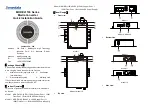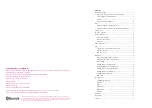
7
PS-PLAY IP to Audio Streaming Decoder 3
3. PS-PLAY IP to Audio Streaming Decoder
Introduction
The PS-PLAY is a freestanding IP to audio converter which is also available
in a 1U rack-mount as the PS-PLAYS. It takes an IP audio feed and converts
it to a number of simultaneous stereo outputs: balanced and unbalanced
analogue audio, AES/EBU, S/PDIF & TOSlink digital audio outputs.
As for the PS-SEND, all the configuration settings for the unit are accessed
via a local web-server built into it. The unit can decode one of a number
of audio streams, such as those generated by the PS-SEND (MP3, G.711
and PCM) and including Ogg Vorbis and WMA audio files from external
USB as well as from sources such as Shoutcast, Icecast (Internet radio),
VLC and from RTP servers. The unit can receive streams from HTTP (TCP/
IP) and RTP (UDP) protocols, as well as raw TCP and UDP packets. The unit
can also configure its own IP address using DHCP/BOOTP, IPzator or AutoIP.
A readout of the set IP address can be heard on every reset using SONICIP
technology, if selected.
Two red and green front panel LEDs indicate what state the unit is currently
in, be it normal operational mode or bootstrap mode, and also indicates
the current network connection status. A blue LED denotes power to the
unit. The audio output can be monitored on the front panel ¼” (6.35mm)
Fig 3-1: PS-PLAY Front Panel
stereo jack socket in combination with a headphone volume knob. The
analogue audio outputs can be switched to be either a fixed level output or
to be controlled by the front panel volume knob. The volume can also be
adjusted, as well as many other features, using an infra-red remote control
(available separately).
The PS-PLAY can be configured with up to 3 sources. The sources are
prioritized in number order. If one has failed, the next one will attempt to
play. If all fail, an external USB drive will be used as a back-up source. The
external USB plugs into the USB socket on the front of the unit. This enables
the PS-PLAY to act as a USB audio player, playing any of the audio formats
previously mentioned.
The rear panel has 2 x RJ45 connectors, one for the 10/100Mbit Ethernet
interface and one for GPIO connections. The PS-PLAY has 2 output relay
contacts which can be triggered remotely over IP from a connected
PS-SEND unit. There is a 9 way D-type RS232 serial connection for control
of the unit by automation systems and for firmware updates. The unit
can be remote controlled via serial connection, TCP or UDP and remote
management of the unit is also possible using SNMP traps.
















































